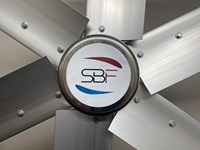FREQUENTLY ASKED QUESTIONS
THE QUESTIONS YOU ASK MOST LAID OUT ON ONE PAGE. IF YOU DON'T FIND AN ANSWER, DON'T HESITATE TO REACH OUT TO US.
GENERAL QUESTIONS
What can I mount the fan on?
The STOL and TurboProp series fans come with an I-beam mounting kit and can be mounted on I-beams, angle irons or unistruts. Additional kits are available for mounting between purlins. Check the installation manual and consult a structural engineer if in doubt.
Why are Skyblade Fans better?
Skyblade airfoils are engineered with STOL TECHNOLOGY (Short Take Off & Landing) to obtain the greatest amount of lift at slower speeds. The more lift the airfoil can generate the greater amount of air which is forced towards the floor.
Due to an increase of lift created by the airfoil, Skyblade fans can operate at slower speeds with less power consumption and more airflow than other styles of airfoils.
Skyblade airfoils are anodized aluminium which means they will still look great in 10 years. Airfoils that are not anodized can become a bit chalky. It pays to check.
How do HVLS fans cool me?
Fans achieve a cooling effect through the body's own mechanism of perspiration and evaporation. The airflow passes over the body increasing the rate of evaporation which makes you feel cooler. Fast moving, turbulent air can become uncomfortable whereas Skyblade fans move a large column of air down and across the space to create a gentle, calming breeze with effective cooling.
What is the Warranty on a Skyblade fan?
Skyblade shall repair or replace warranted defective parts as follows:
Lifetime warranty on fan blades, chassis and hub
Three-year limited warranty on motor and reducer
One-year limited warranty on controls
Who can Install Skyblade fans?
The installer needs to be a competent and licensed electrician. Skyblade fans do not restrict who can install your fan and if the installation is according to the instructions in the manual your warranty is not affected. If you prefer, contact us and we can arrange installation through one of our many partners.
How high should I mount the fan?
A standard ceiling fan should be mounted so that the bottom of the fans hub is 85cm below the beam on which it is mounted. Fan blades should be mounted between 3m and 15m above the floor with optimal height between 6m and 9m. If desired, extension bars are available to lower the fan. Avoid mounting the fans directly below lights or skylights to avoid a strobe effect caused by the moving blades.
What clearance do I need?
The fan needs to be installed so that it is free from machinery, stores and other obstacles. The area within 15% of the diameter when the fan is at rest is considered "close clearance". It is extremely dangerous to mount the fans within close clearance of any object or path of an object. We strongly recommend not mounting the fan closer than 15% of its diameter to any object or its path. If this is an issue, extension bars and smaller fans are available from Skyblade fans.
What size fan do I need?
In Australia and New Zealand, Skyblade fans are normally used for cooling applications. A rough rule of thumb is if you divide the length of the space by 5, a fan with that diameter will provide suitable cooling effect. Please contact us if you have any questions.
What is HVLS?
HVLS stands for High Volume, Low Speed. SkyBlade's HVLS fans move more air at a low rotational speed.
What is Destratification?
Destratification is the process of minimising the temperature differential from the ceiling to the floor by mixing stratified layers of heat that occur due to warm air rising and cool air falling. The unique wingtips and airfoils on SkyBlade Fans can bring down that heat trapped towards the ceiling when operating at a low setting. This mixes the air and creates a consistent temperature throughout your building allowing you to lower your thermostat settings, increasing the life of your equipment and reducing heating bills by up to 30%.
What are the benefits of HVLS Fans?
HVLS fans have many benefits: evaporative cooling, destratification, cost-effective, energy-efficient, quiet operation, eliminates hot and cold spots, reduces condensation, reduces mold and mildew, improves working conditions, improves air quality, employee comfort, warehouse safety, and more!

